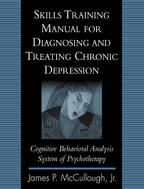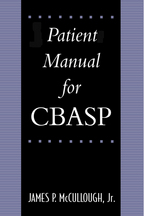Treatment for Chronic Depression
Cognitive Behavioral Analysis System of Psychotherapy (CBASP)
James P. McCullough, Jr.
1. A Therapist's Problems with a Chronically Depressed Patient
2. Introduction to Chronically Depressed Patients and the CBASP Program
3. Understanding the Psychopathology of Chronically Depressed Patients
4. Course Patterns, Comorbidity, and Psychological Characteristics
II. CBASP Method and Procedures
5. Strategies to Enhance Motivation for Change
6. Elicitation Phase of Situational Analysis
7. Remediation Phase of Situational Analysis
8. Using the Therapist-Patient Relationship to Modify Behavior
9. Measuring Acquisition Learning and Generalized Treatment Effects
III. History and Other Aspects of CBASP
10. CBASP Emergence on the National Scene
11. Training CBASP Psychotherapists
12. Comparison of CBASP to Beck's Cognitive Therapy and Klerman's Interpersonal Psychotherapy Models
13. Resolving Common Patient Problems and Crises
Appendix A: Therapist Prompts for Administering Situational Analysis (PASA)
Appendix B: Rating Scales for Adherence Monitoring and for Evaluating the Quality of the Interpersonal Relationship
Appendix C: Rating the Presence of Optimal CBASP Psychotherapist Qualities and Abilities













